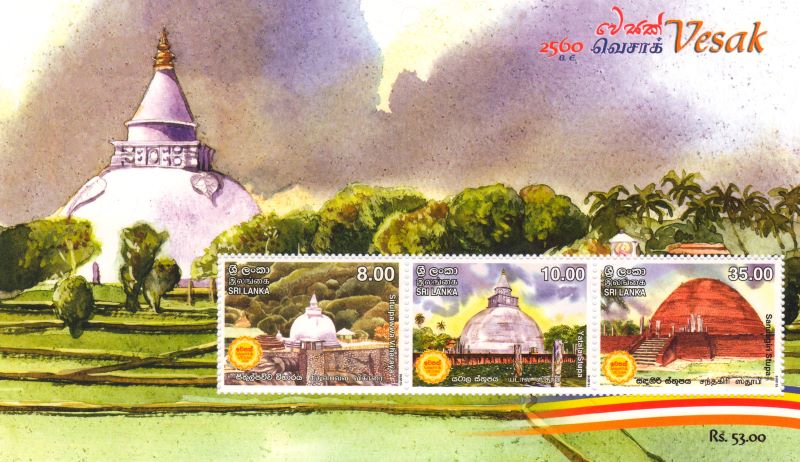WORLD BUDDHIST STAMPS e.GALLERY
bringing the buddhist world at the comfort of your home
| Wesak 2016 - Sri Lanka | |
Stamps depicting the Stupas printed to commemorate the Wesak celebrations in Sri Lanka.
Situlpawwa Viharaya
Sithulpawwa Rajamaha Viharaya is an ancient Buddhist monastery located in Hambantota District, South Eastern Sri Lanka. Situated 18 km east of the pilgrimage town Katharagama, it is believed to have been built in the 2nd century B.C by king Kavantissa. The name Sithulpawwa is derived from the word "Chiththala Pabbatha", which means he hill of the quiet mind.
This ancient monastery with a history over 2200 years, was a place of worship for devotees as well as a center of Buddhist education for Buddhist monks. Paintings of the Anuradhapura era and the ruins of stone Buddha images, Bodhisattva images, Image Houses, Circular Relic Houses are spread throughout the monastery premises.
Yatala Stupa
Yatala Vehera is an ancient Buddhist stupa dating back to the 3rd Century B.C, located in Deberawewa - Thissamaharama in Hambantota District of Sri Lanka. The stupa is built on a stage made of large flat granite stones and has a surrounding wall of sculpted elephant heads, a moat and a large moonstone. It is believed that the stupa was built 2300 years ago by regional king Yatala Thissa of Ruhuna to commemorate the place where he was born. It is not known what was enshrined in this stupa but a large number of relic caskets has been discovered in the stupa
Sandagiri Stupaya
According to the Great Chronicle Maha Vamsa, when the Sri Maha Bodhi was brought to Sri Lanka by Theiree Sangamitta, members of the ‘Kshethiya’ clan of ‘Chandana Grama’ was present at Anuradhapura taking part of the celebrations. It is now accepted that the ‘Chandana Grama’ is the area now known as Sandagiriya.
Emperor Asoka also send various relics as gifts to the Sri Lankan king Devanampiyathissa (250-210 BC) and it is believed that they were handed over to his brother Mahanaga who was a regional king in the Ruhuna. The king Mahanaga built Sanadagiri Stupa enshrining these relics and a rare conch shell in the 3rd century BC.
All the ruins which had been discovered around the Sandagiri Stupa has been displayed around the Welimaluwa. These include “Siri Pathul Gal” (foot print of Buddha carved in rock slabs) which were objects of veneration in the 2-3 rd century BC, before the Buddha statues were used.
|
|
| Issued Country | Sri Lanka |
| Issued Year | 2016 |
| Category | Buddhist Architect Events Buddhist Landscape |
| Type | Commemorative/Special Stamps |
